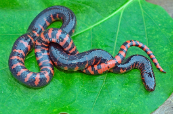Eastern Mud Snake (Farancia abacura abacura)
Description: Most adult Mud Snakes are about 40–54 inches in total length. Adults are large, thick bodied, and quite beautiful. The body is mostly glossy black (iridescent blue in the sunlight) with the ends of 53 or more red to pink bars from the belly extending onto the sides. The belly typically has a pattern consisting of alternating black and red or pink bars. The neck is thick and indistinct. The scales on the upper and lower lips, chin, and throat are yellowish and each has a dark spot. The iris is red. Juveniles are similar in appearance to adults, but the red to pink bars from the belly extend higher onto their sides.
Habitat: Mudsnakes prefer habitats with still or slow-moving freshwater such as cypress swamps, drainage ditches, canals, marshes, rivers, and lakes. These primarily aquatic snakes are especially fond of waters with dense aquatic vegetation and with muddy bottoms and banks, but they will also enter tidal creeks and other areas with brackish water. Adults and juveniles of this species are occasionally found in suburban neighborhoods where development encroaches into favorable habitats.
Range: Eastern mud snakes can be found as far north as Virginia's southern Coastal Plain, and as far south as the southern tip of Florida.
Diet: Farancia abacura eats aquatic amphibians, including Amphiumas (Amphiuma means), Greater Sirens (Siren lacertina), earthworms, tadpoles, small salamanders, and some frogs and fish. Enlarged teeth occur at the rear of the upper jaw, which presumably aid in holding slippery prey.
Reproduction: Females lay eggs in early summer in sandy upland habitats near water and sometimes attend the eggs until they hatch. Although large females may lay over 100 eggs, average clutch size is probably closer to 20-30 eggs. Young hatch in late summer but may overwinter in the nest before emerging. Females construct a nesting cavity in loose soil or debris and stay with the eggs until they hatch. Nests of American alligators are favorite nesting sites for these snakes. The eggs typically hatch between August and October.
Status: Listed as Least Concern in view of its wide distribution, presumed large population, and because it is unlikely to be declining fast enough to qualify for listing in a more threatened category.
»» Kingdom: Animalia - Animals
»» Phylum: Chordata - Chordates
»» Subphylum: Vertebrata - Vertebrates
»» Class: Reptilia - Reptiles
»» Order: Squamata - Scaled Reptiles
»» Suborder: Serpentes
»» Superfamily: Colubroidea
»» Family: Colubridae - Colubrids
»» Genus: Farancia
»» Species: Farancia abacura - Mud Snake
»» Subspecies: Farancia abacura abacura - Eastern Mud Snake
This article uses material from the Wikipedia article "Mud Snake", which is released under the Creative Commons Attribution-Share-Alike License 3.0. Content may have been omitted from the original, but no content has been changed or extended.
|








